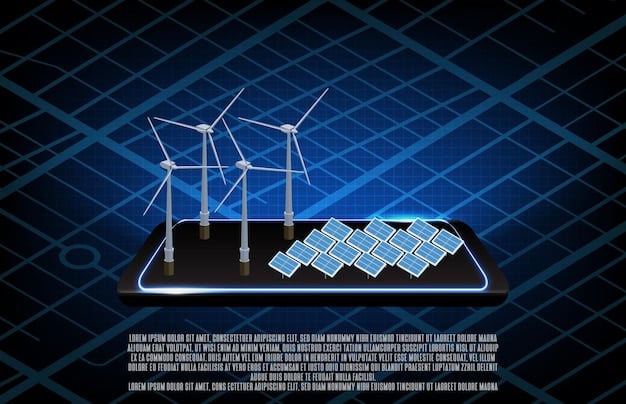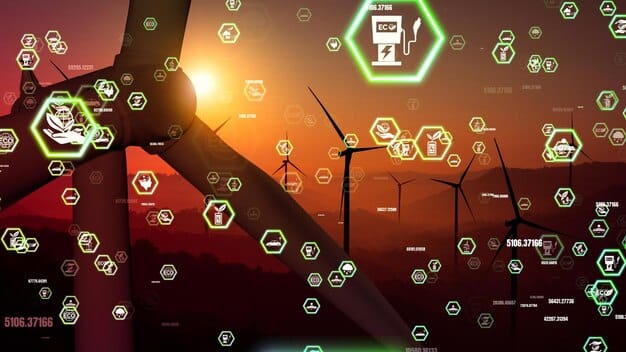Blockchain for Renewable Energy: Boosting Transparency in Trading

Blockchain technology enhances transparency in renewable energy trading by creating a secure, immutable ledger for tracking energy transactions, verifying sources, and streamlining complex processes, fostering trust and efficiency among participants.
The integration of blockchain technology is revolutionizing various sectors, and the renewable energy market is no exception. But how can blockchain technology enhance transparency in renewable energy trading? This article delves into the multifaceted ways blockchain is transforming the renewable energy landscape, making it more transparent, efficient, and trustworthy.
Understanding the Basics of Blockchain Technology
To fully grasp the impact of blockchain on renewable energy trading, it’s essential to understand what blockchain technology entails. Blockchain is fundamentally a distributed, decentralized, public ledger that records transactions across many computers. This design ensures that no single entity controls the data, enhancing security and transparency.
Key Features of Blockchain
Blockchain technology is characterized by several key features that make it particularly well-suited for applications requiring high levels of trust and transparency. These features include decentralization, immutability, and security.
- Decentralization: No single entity controls the blockchain, reducing the risk of manipulation.
- Immutability: Once a transaction is recorded, it cannot be altered or deleted, providing a verifiable history.
- Security: Cryptographic techniques secure the blockchain, making it resistant to fraud and unauthorized access.
These features collectively contribute to a system where trust is embedded in the technology itself, rather than relying on intermediaries. This trust is crucial in sensitive applications like renewable energy trading.
Blockchain’s structure and security mechanisms provide new ways to address transparency challenges in complex systems, promising more reliable and efficient operations. Its inherent characteristics support more open and honest interactions.
The Current State of Renewable Energy Trading
Renewable energy trading faces several challenges that hinder its growth and adoption. The current systems often lack transparency, leading to inefficiencies, mistrust, and barriers to entry for smaller players. Understanding these challenges is crucial for appreciating how blockchain can offer significant improvements.
Challenges in Renewable Energy Trading
The renewable energy sector, while growing rapidly, is often plagued by opacity and complexity. These issues can discourage investment and slow down the transition to more sustainable energy sources.
- Lack of Transparency: Opaque trading processes make it difficult to verify the origin and authenticity of renewable energy certificates (RECs).
- Inefficiencies: Traditional trading systems involve multiple intermediaries, resulting in delays and higher transaction costs.
- Mistrust: Without a clear and verifiable record of transactions, participants may lack confidence in the integrity of the market.
These challenges highlight the need for a more transparent and efficient system that can foster greater trust and participation in renewable energy trading. Blockchain addresses these challenges by providing a transparent, secure, and decentralized platform.
Existing renewable energy trading platforms often depend on centralized authorities, which can lead stakeholders to question their neutrality. By adopting blockchain, renewable energy markets can ensure all transactions are visible and validated across a distributed network.

How Blockchain Enhances Transparency
Blockchain technology’s ability to enhance transparency in renewable energy trading stems from several key aspects of its architecture. These include improved tracking of renewable energy certificates (RECs), enhanced data integrity, and streamlined trading processes.
Improved Tracking of Renewable Energy Certificates (RECs)
RECs are a crucial part of the renewable energy market, representing proof that a certain amount of electricity was generated from a renewable source. Blockchain can significantly improve the tracking and management of RECs.
By recording each transaction related to RECs on a blockchain, it becomes possible to create an immutable and transparent record of their origin, ownership, and usage. This enhanced traceability reduces the risk of fraud and double-counting, ensuring the integrity of the renewable energy market.
Enhanced Data Integrity
Data integrity is paramount in any trading system. Blockchain ensures that all data recorded on the ledger is accurate and cannot be tampered with. This is achieved through cryptographic techniques and a distributed consensus mechanism, where multiple participants must verify each transaction before it is added to the chain.
The immutability of blockchain data means that once a transaction is recorded, it cannot be altered or deleted. This provides a reliable and verifiable history of all trading activities, fostering trust among participants and reducing the potential for disputes.
Ultimately, blockchain enhances transparency through superior data management, making renewable energy trading more reliable and trustworthy. This enhanced transparency enables better decision-making at all levels.
Real-World Applications of Blockchain in Renewable Energy
Several pioneering projects and companies are already leveraging blockchain technology to enhance transparency in renewable energy trading. These real-world applications demonstrate the practical benefits and potential of blockchain in transforming the renewable energy landscape.
Examples of Blockchain Implementation
Innovative energy companies and startups are exploring how blockchain can revolutionize energy trading. Key projects include:
- Power Ledger: Australian company Power Ledger uses blockchain to facilitate peer-to-peer energy trading, allowing households with solar panels to sell excess energy directly to their neighbors.
- Energy Web Foundation: EWF is developing a decentralized operating system for the energy sector, enabling various blockchain-based applications, including RECs tracking and grid management.
- LO3 Energy: This company has implemented a microgrid project in Brooklyn, New York, using blockchain to enable local energy trading among residents.
These examples highlight the versatility of blockchain in addressing different aspects of renewable energy trading. They show how blockchain fosters innovative business models that involve a broader range of stakeholders.
These blockchain implementations are not just theoretical; they offer tangible benefits, such as reduced transaction costs and increased participation. These benefits drive broader adoption and acceptance of blockchain technology in energy markets.

Benefits and Challenges of Blockchain Adoption
While blockchain offers numerous benefits for enhancing transparency in renewable energy trading, its adoption also presents certain challenges. Understanding these benefits and challenges is essential for successfully implementing blockchain solutions.
Advantages of Blockchain Implementation
Adopting blockchain in renewable energy trading leads to several clear advantages that improve market dynamics and stakeholder confidence.
Improved Efficiency and Reduced Costs
By eliminating intermediaries and automating trading processes, blockchain can significantly reduce transaction costs and improve efficiency. Smart contracts, self-executing agreements written into the blockchain code, can automate many of the administrative tasks involved in trading, further streamlining operations.
The automated nature of blockchain transactions minimizes human error, accelerating processes and cutting down on operational overhead. This makes renewable energy trading more accessible to many participants.
Increased Market Participation
The transparency and trust provided by blockchain can encourage greater participation in the renewable energy market. Smaller producers and consumers, who may have been excluded from traditional trading systems, can now participate more easily, fostering a more inclusive and competitive market.
Blockchain’s decentralized nature allows for the creation of new business models, such as peer-to-peer energy trading. These models empower consumers and producers, driving more sustainable practices.
Challenges to Overcome
Despite its considerable advantages, blockchain adoption faces certain hurdles that require careful mitigation. These include scalability issues and regulatory uncertainties.
- Scalability: Some blockchain networks may struggle to handle the high volume of transactions required for large-scale energy trading.
- Regulatory Uncertainties: The legal and regulatory framework for blockchain-based energy trading is still evolving, creating uncertainty for market participants.
- Technological Complexity: Implementing and maintaining blockchain solutions requires specialized expertise, which may be a barrier for some organizations.
Addressing these challenges will require technological innovation, regulatory clarity, and greater awareness and understanding of blockchain technology. Collaboration among industry stakeholders, policymakers, and technology providers.
Overcoming challenges associated with blockchain will allow the renewable energy market to experience profound benefits. By addressing these obstacles, blockchain can revolutionize renewable energy trading.
The Future of Blockchain in Renewable Energy Trading
The future of blockchain in renewable energy trading looks promising, with ongoing technological advancements and increasing regulatory support paving the way for wider adoption. Blockchain has the potential to fundamentally transform how energy is traded, produced and consumed.
Potential Developments and Trends
Looking ahead, several developments and trends are likely to shape the future of blockchain in renewable energy. This includes advancements in blockchain scalability, interoperability, and the integration of blockchain with other technologies.
The integration of blockchain with the Internet of Things (IoT) will enable more granular and real-time monitoring of energy production and consumption. This will enhance the accuracy and efficiency of energy trading, providing a comprehensive view of the energy landscape.
- Scalability Solutions: Innovations such as layer-two protocols (e.g., Lightning Network) and sharding are improving the ability of blockchain networks to handle a large number of transactions.
- Interoperability: Efforts to improve the interoperability of different blockchain networks will enable seamless trading of energy and RECs across multiple platforms.
- Smart Grid Integration: Blockchain can be integrated with smart grids to enable more efficient and decentralized energy distribution and management.
These developments will make blockchain-based energy trading more scalable, accessible, and integrated with the broader energy ecosystem. They promise to unlock new opportunities for innovation and collaboration.
The promise of blockchain in renewable energy is profound, offering a glimpse into a future where energy markets are transparent, efficient, and sustainable. By seizing its potential, the renewable energy sector can drive innovation and revolutionize practices.
| Key Point | Brief Description |
|---|---|
| ✅ REC Tracking | Immutable tracking of Renewable Energy Certificates from creation to retirement. |
| 🔒 Data Integrity | Ensures data accuracy and prevents tampering using cryptographic techniques. |
| ⚡ Efficiency | Reduces transaction costs by eliminating intermediaries. |
| 🤝 Participation | Encourages participation by smaller producers and consumers. |
Frequently Asked Questions
▼
Blockchain is a decentralized, distributed, and public digital ledger used to record transactions across many computers. It is secure and transparent, making it ideal for various applications.
▼
Blockchain creates an immutable record of all transactions, enhancing transparency and reducing the risk of fraud. It also streamlines processes and lowers transaction costs, boosting trust in the system.
▼
RECs represent the environmental attributes of electricity generated from renewable energy sources. Each REC represents one megawatt-hour (MWh) of renewable electricity, enabling tracking and verification of renewable energy usage.
▼
Challenges include scalability limitations, regulatory uncertainties, and the technological complexity associated with implementing blockchain solutions. Overcoming these challenges requires advancements and clear regulatory frameworks.
▼
The future entails wider adoption, advancements in scalability and interoperability, and integration with technologies like IoT. Expect more decentralized energy solutions and efficient energy distribution.
Conclusion
In conclusion, blockchain technology offers a compelling solution to enhance transparency in renewable energy trading. By providing a secure, immutable, and decentralized platform, blockchain can address the challenges of opacity, inefficiency, and mistrust that currently plague the renewable energy market. As technology continues to evolve and regulatory frameworks become clearer, blockchain has the potential to revolutionize the way renewable energy is traded, leading to a more sustainable and equitable energy future.





